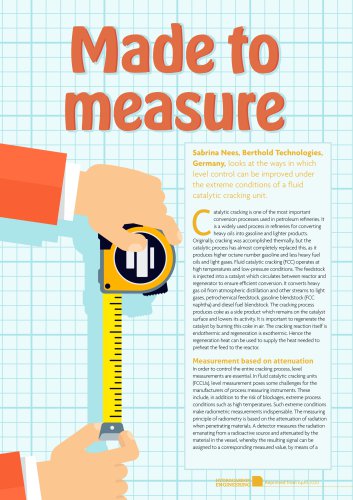
Catalog excerpts
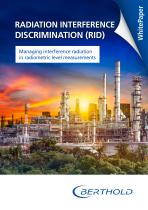
Managing interference radiation in radiometric level measurements RADIATION INTERFERENCE DISCRIMINATION (RID)
Open the catalog to page 1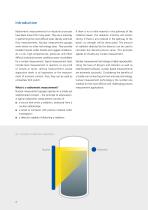
Introduction Radiometric measurements for industrial processes have been around for many years. They are a mainstay in performing the most difficult level, density and bulk flow measurements. Nuclear measurement gauges work where no other technology does. They provide excellent results under hostile and rugged conditions. As a rule, high temperatures, pressures and other difficult industrial process conditions pose no problem for a nuclear measurement. Typical measurement tasks include level measurement in reactors, or any kind of vessels or tanks, density measurement, phase separation...
Open the catalog to page 2
Radiometric Measurement Radiation sources There are many known natural and artificial isotopes, not all of them are used for radiometric measurement. In industrial applications only, a few nuclides are actually used for measurement purposes. The radioactive isotope is usually placed in a rugged, steel-jacketed, lead housing for maximum safety. The housing shields the radiation, emitted from a radioactive isotope, except in the direction where it is supposed to travel. Using a small collimated aperture in the shielding, the beam can be projected at various angles into the pipe or vessel....
Open the catalog to page 3
In some cases, it is beneficial to have the scintillator covering a longer range, this is called a rod detector. Typically, in level measurements either source or detector span the whole measuring range. Their length can be up to 8 m. The main benefit of a rod detector is its lower cost compared to a rod source. Albeit, the rod source would be the technologically superior system. The gamma radiation, which a rod detector is able to detect, is influenced by the geometry of the radiation array. However, as rod detectors are typically not shielded (shielding would also diminish the cost...
Open the catalog to page 4
Dealing with interference radiation One way to reduce background radiation is to protect the detector from noise by using huge lead shields. However from a customer’s point of view this is not very commercially attractive, neither from a mechanical engineering nor from an installation perspective. An independent measurement of the background radiation with a separate detector (not exposed to the radiation of the nuclear gauge) can also help to detect and suppress the interference. However, this increases the cost and adds to the complexity of the system and the probability of errors –...
Open the catalog to page 5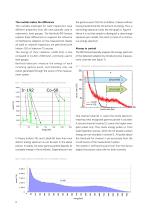
The nuclide makes the difference The nuclides employed for weld inspections have different properties from the ones typically used in radiometric level gauges. The Berthold RID feature exploits these differences to suppress the influence of interference radiation on the measurement. Nearly all weld or material inspections are performed with Iridium-192 or Selenium-75 sources. The energy of their radiation (<600 keV) is low compared to Co-60 (>1000 keV), commonly used in level gauges. Berthold detectors measure the energy of each incoming gamma event, and therefore only use events generated...
Open the catalog to page 6
It records the readings of both channels separately and compares them. If the process value for channel 1 and channel 2 is identical or within the threshold (measurement point 1 and 2 or 1 and 3 in figure 8), the system treats this as a normal process condition. In case of a difference in process value greater than the configured threshold, the system automatically identifies this as an interference radiation event and switches measurement to channel 2 (i.e. measurement points 1 and 4 of figure 8). The threshold of this switch over can be adjusted in the system setting. Obviously, this...
Open the catalog to page 7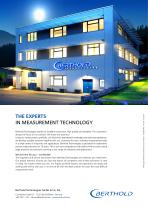
Berthold Technologies stands for excellent know-how, high quality and reliability. The customer is always the focus of our solution. We know our business! Using our varied product portfolio, our enormous specialized knowledge and extensive experience, we develop suitable solutions together with our customers for new, individual measurement tasks in a wide variety of industries and applications. Berthold Technologies is specialised in radiometric process measurements for 70 years. This is our core competence with state-of-the-art and cutting edge products and solutions covering a vast range...
Open the catalog to page 8All Berthold Technologies Process Control catalogs and technical brochures
-
Density measurement
5 Pages
-
Continuous level measurement
5 Pages
-
Retrofit
3 Pages
-
Article "Made to measure"
3 Pages
-
Moisture in pasta production
3 Pages
-
Glass level measurement
3 Pages
-
Mould level measurement
4 Pages
-
LB 475 Fracturing system
3 Pages
-
Multiphase level measurement
7 Pages
-
Produkt InlineSENS
4 Pages
-
Industry Sugar
9 Pages
-
LB472 Bulk Flow Meter
12 Pages
-
MEVIS
4 Pages
-
NUMo - LB 134 UMo II
2 Pages
-
Radiation Protection Instruments
12 Pages
-
Micro-Polar
16 Pages
-
DuoSeries Detectors LB 4700
2 Pages
-
Rod Source Shielding
4 Pages
-
Safety Source Capsule SSC
2 Pages
-
Level Switch LB 471
6 Pages






